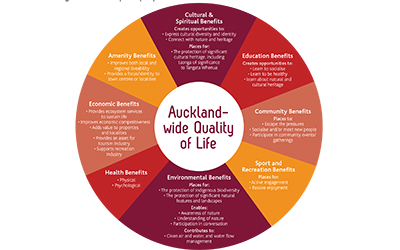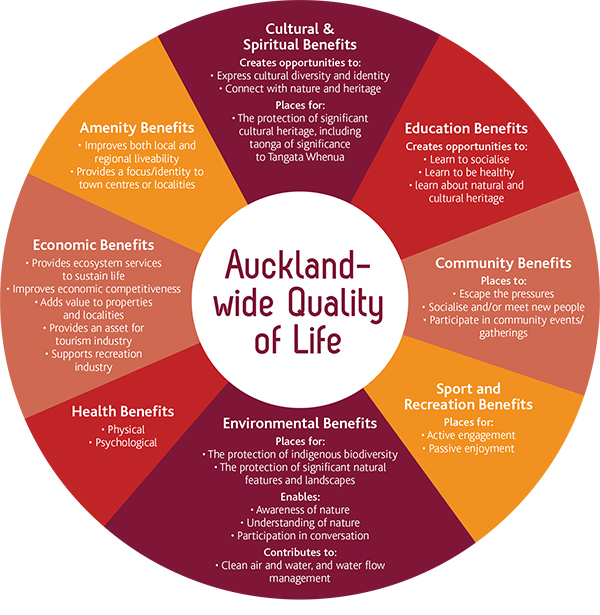Mayor silent on Aucklanders’ affair


Benefits of Public Open Space: Figure 10.2 of the Draft Auckland Plan depicts the multifarious beneficial aspects of Public Open Space, which are epitomised by the Auckland Regional Parks. image Draft Auckland Plan
It was once a paradise fought over by a hundred lovers—makaurau. Today, rather than a hundred, there are 1.5 million lovers, or residents of the region.
But particularly, they are passionate lovers of Makaurau’s 26 regional parks. According to the Encyclopaedia of New Zealand:
Four to five million people visit the parks annually, three-quarters of them Auckland residents.
Putting this in the perspective of the Rugby World Cup, Auckland Tourism, Events and Economic Development is expecting fewer than a million international visitors to Aotearoa, and 70–80% of those to the metropolis.
Mayor Len Brown, in his 1600-word introduction to the Draft Auckland Plan, doesn’t mention the 42 400-hectare regional park network once—not even by the other terms used in the draft plan, such as network of parks, open space network etc. Closest the mayor comes is:
The mayor’s omission of the parks shouldn’t be seen as ominous. The draft plan itself contains a dozen references to the region’s network of parks, some of them entirely encouraging:
Prepare a public open space acquisition strategy for the next 30 years
The mayor concludes his foreword with fulsome acknowledgement of the more than 8000 individuals and organisations that provided input to the draft plan, and a plea to keep it coming:
Please let me have your views on these plans—what you agree with, where we have missed the mark and whether we are on the right track to create the Auckland you want.
Auckland has the chance to do something great, the chance to set a new course. I detect a sense of excitement, possibility and optimism in the air! Let’s keep up the momentum.
In that spirit, the Mahurangi Magazine lists the clauses from the draft plan that mention regional parks specifically or generally…
…in the hope a hundred lovers put their oar in.
Regional parks network clauses
p.21 To maximise the quality of living in Auckland we need to value our environment, find ways to reduce negative impacts upon it and participate in finding solutions to global environmental challenges. Auckland (and its surrounding regions) is highly prized for:
- our splendid harbours, islands and beaches
- the wild west coast and gentler east coast
- our extensive rural environment to the north and south
- our volcanic landscape
- our built heritage
- our extensive network of parks and open spaces
- our native bush.
p.25 Auckland has a tremendous linked network of green and public open space – from maunga to moana. Our safe streets, parks and playgrounds are lined with trees and form green oases throughout the city. Protected native bush and wetlands abound and help create our many stable eco-systems.
p.35 Auckland is blessed with a green public open space network anchored in the west by the Waitakere Ranges and in the south by the Hunua Ranges, the latter being shared with neighbouring Waikato. This network, along with the volcanic landscape and our extensive rural environment, shapes Auckland’s sense of open space and is critical to our character, identity and lifestyle. Our green environment and the associated recreational opportunities are significant to Aucklanders and to visitors. Our network of parks and rural areas together with Auckland’s extensive marine and coastal environment are defining factors and give us a reputation of being a green city and a “city of sails”. This Plan contains policies to ensure that our green and blue rural, coastal, marine and natural environments can co-exist in a balanced way with the working activities that leverage off them and help sustain us (see Chapters 5 and 7).
p.82 Map 5.2 shows the public open space network and identifies regionally and nationally significant recreational areas and open spaces. These include Auckland’s unique network of regional parks, which was established in 1965 and is made up of 26 different parks, covering more than 40 000 hectares of land with recreational, historic and ecological value. The parks provide a diversity of experience from Ambury Farm Park in Mangere to the coastal parks such as Tawharanui to the north and Tapapakanga to the south, and native bush in the Waitakeres. Access to all our parks is free of charge.
p.101 Most of Auckland is rural. Our large rural areas are a spectacular attribute. They host diverse economies and activities, and include stunning landscapes and coastal areas – the West Coast; Hunua and Waitakere ranges; the Kaipara, Manukau Mahurangi and Whangateau harbours; Gulf Islands, numerous regional parks and much more. They are also where rural people make their living and where many urban Aucklanders connect with nature. Our rural areas vary hugely in terrain, land uses and settlement patterns across 384 000 hectares of land, comprise over 70% of Auckland’s landmass, and are in turn contained by over 3700 kilmetres of coastline. They are an integral part of Auckland’s character and economy, and vital to it’s people.
p.154 Auckland benefits from an outstanding natural landscape. Proximity to the sea affords Aucklanders an almost incomparable range of marine activities; extensive regional parks abound; and within the city itself, public open spaces such as the Auckland Domain and One Tree Hill Domain provide impressive natural amenity. Access to our bountiful natural environment is a significant advantage to living in Auckland and draws skilled migrants here. Auckland’s public open space network, including the network of associated trails and walkways, contributes significantly to its unique identity, quality of life, healthy lifestyle and economic well being. The public open space network must be recognised and managed as an integrated system of individual places, corridors and links. Private open space is also recognised for its contribution to the feeling of ‘spaciousness’ in Auckland. The challenge is to maintain and enhance the public open space network as the population grows and diversifies, while also protecting and enhancing the values associated with particularly sites. Map 10.2 illustrates Auckland’s potential future open space network investments (public open space is discussed further in Chapter 1 and 5). The Council will ensure that public open space is planned for and delivered in line with the growing population, recognising its benefits to Aucklanders (Figure 10.2). It will work with others to ensure that the public have good access to the public open space network, the network of regional parks and other coastal recreational areas.
p.171 Rural production is important to Auckland (see Chapter 7). Rural roads provide Aucklanders with access to a number of regional parks and a myriad of other recreational opportunities. Our rural areas are also increasingly becoming visitor destinations for tourists and Aucklanders, which increases the volume of traffic on those roads.
p.176 Council has considerable latitude in the way it spends the rates that it levies. Rates are used to fund services for broad use by the population where it is difficult to identify and charge specific users. Examples include funding for roads and parks, which are accessed by most of the population. Rates can also be used for social equity reasons where council determines that people should have access to a particular service regardless of their ability to pay (such as library services). General rates funding may be supplemented by other funding mechanisms. These include:
p.190 Regional parks acquisition $160 million
p.224 Prepare a public open space acquisition strategy for the next 30 years
